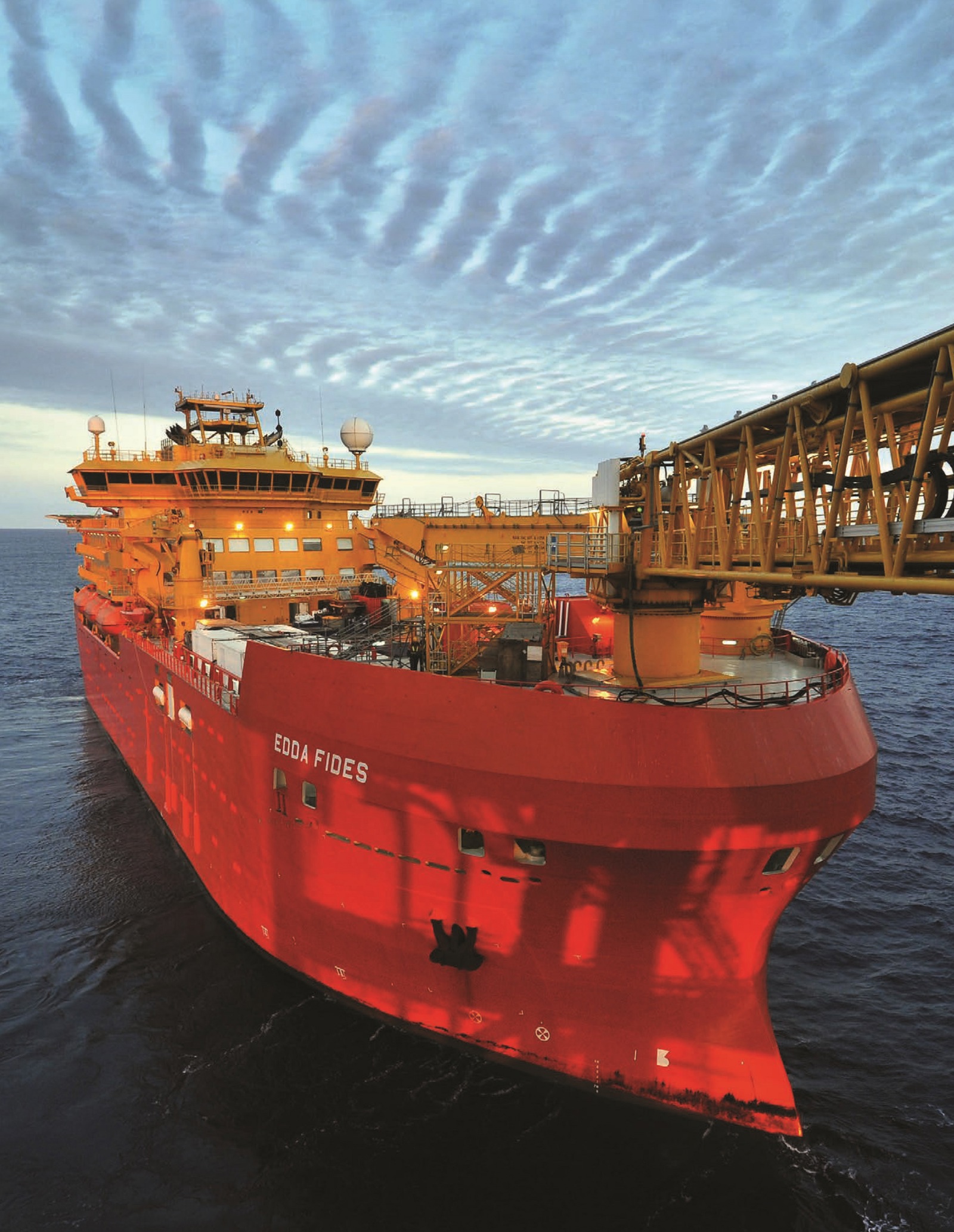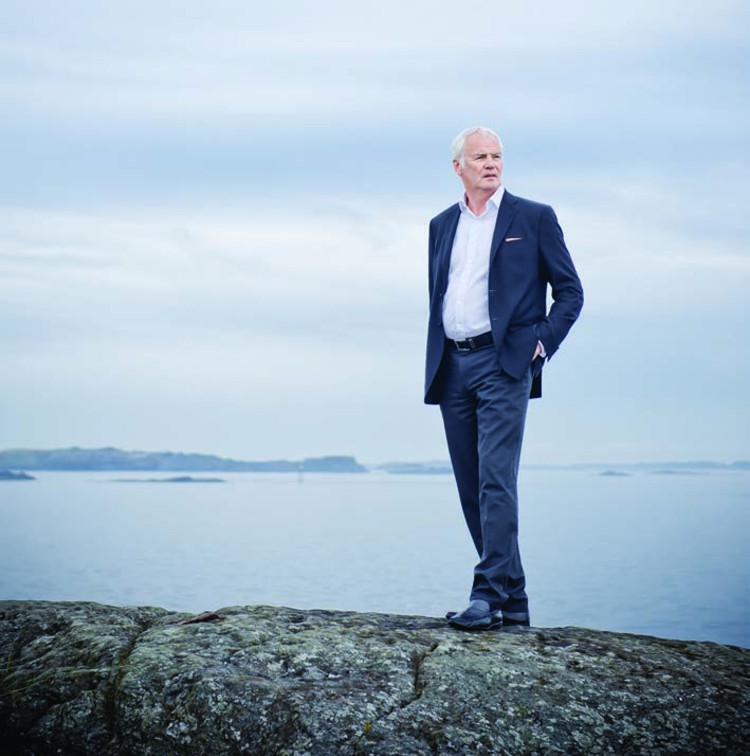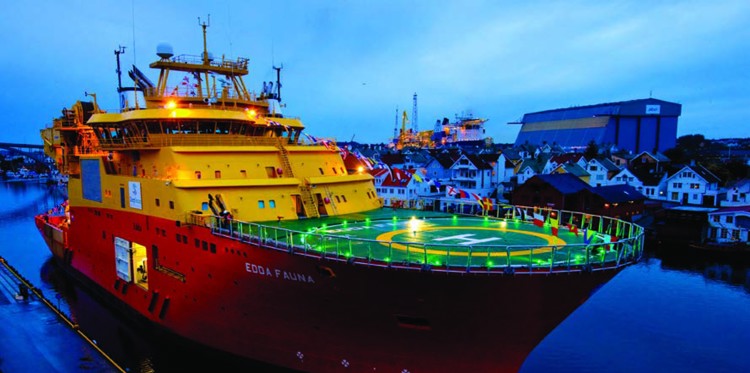
It is fitting that Østensjø Rederi should have its newly renovated offices beside a channel that runs into the North Sea. This harsh ocean area and its offshore industry has been the company’s lifeline since 1973 when owner, Johannes Østensjø, signed the firm’s first deal for two supply vessels.
-
Text:Kongsberg Maritime Communication
-
Gunvor Hatling MidtbøVice President, Communications
Johan Rokstad is in his corner office typing and talking on his mobile. The room is inviting and bright, brought to life with a picturesque view of a sea channel and old wooden buildings, remnants of Haugesund’s traditional architecture and culture.
Tucking a mobile between a left shoulder and ear while punching feverishly at a keyboard could be both intimidating and challenging for most people. Not for Østensjø’s CEO. If there is a possibility, there is a way. And challenges … well he thrives on challenges, seemingly the more, the better.
“I became a deckhand at the age of 15. I didn’t see my parents for two years. At 19 I enrolled in the maritime academy and some years later at the age of 27 captained my first offshore support vessel (OSV) for Østensjø,” says 64-year old Rokstad with a boyish grin. “Life has been an adventure.”
In the Captain’s chair for over five years, he jumped ship and joined Swedish-owned Consafe, the leading name in the design and building of semi-submersible floatels, gaining valuable management experience in offshore accommodation and rigs.
Somes years later in 1985 at the age of 38, the Master Mariner once again joined Østensjø, this time as operations manager for the company’s growing, highend tug fleet. He would never change companies again.
TUG OF WAR
“We had some frustrating involvement in the past with tugs, but 1985 was pivotal for Østensjø. We secured a major oil and gas service contract for towage, pollution control, fire-fighting and mooring operations,” says Rokstad.
Today, Østensjø has a fleet of 15 tug vessels, including tractor tugs, reverse tractor tugs, harbour tugs and mooring boats involved in escort, oil spill recovery, towage, salvage and shore operations.
POWER IN PSV
While building up its tug fleet, Østensjø also became a leading player in the Platform Supply Vessel (PSV) market and today has a fleet of four robust vessels.
Never afraid of investing in its fleet or pioneering new technologies to make ships safer, greener and more efficient, Østensjø has pioneered dozens of innovations, which have become best in breed across the rest of the industry and the world.
“Østensjø’s relentless pursuit to be in the forefront of vessel operations has pushed PSV technology and safety further and further,” says Rokstad.
Østensjø was the first company to insist on high sides on PSV cargo decks. It was also the first company to install the revolutionary vertical Voith Schneider propeller on its offshore vessels, making them more efficient, and making maneuvering several times more responsive.
“Since 1976 we have had at least one to four vessels on contract to Shell each year. Why? Because we’ve always been at the forefront of PSV design and operations,” he says.

“Østensjø’s relentless pursuit to be in the forefront of vessel operations has pushed PSV technology and safety further and further” - Johan Rokstad, CEO, Østensjø Rederi
His passion for leadership intensifies when, leaning forward over his desk, our conversation focuses on Dynamic Positioning.
“Østensjø was the first company to introduce Dynamic Positioning systems on board PSVs used for conventional cargo operations. We helped pioneer this technology, installing our first DP some 30 years ago. Since then, we have worked closely with KONGSBERG to develop several new DP reference systems,” he says.
COLLABORATION
According to Rokstad, leaders in any industry must collaborate with the best to sharpen their edge over competitors.
“We have been, and will continue to be, frontrunners in technology. KONGSBERG has been our prime supplier and in addition to delivering top technology and equipment, they have been extremely reliable; there when you need them.”
Reaching for the company’s latest corporate magazine, Rokstad turns to page eight to show a onepage picture of Edda Ferd, Østensjø’s newest PSV, hopefully on a longterm contract soon.
“Now this is a PSV. We have developed a new diesel-electric propulsion system that uses less fuel and will set new environmental standards for offshore vessels. There is no other offshore supply ship, either currently in use or in production, which can match this vessel’s low level of greenhouse gas emissions.”
By the time Rokstad became CEO in 1998, Østensjø was experiencing the tail end of a major shipping crisis. The market was up and down. Oil prices fell below USD 10, oil majors were reviewing their contracts and the company downsized its fleet to survive.
But despite extreme market turbulence, Østensjø, together with neighboring shipowner Solstad, launched a new company, DeepOcean, to provide innovative services and technology to the subsea industry. The company ordered two vessels, one for Østensjø and one for Solstad. The two vessels were a tremendous success and boosted the company’s belief in a future positive offshore services market.
“It was success from day one,” says Rokstad, who strongly believes the company’s future hinges on specialist services.
SUBSEA ALL THE WAY
“Subsea is very exciting and was a major contributor to the company’s best year ever in 2012. PSVs have become a commodity whereas ROV/Subsea vessels have tremendous technology challenges ahead. These types of challenges, combined with Østensjø’s years of experience and ideas for new technology, fit us like a glove,” smiles Rokstad.
When asked about doubling the existing ROV/ Subsea fleet (Edda Flora, Edda Fauna and Edda Fonn) from three to six vessels in five years time, he is quick to respond.
“Subsea will grow further. We want to expand, be better and stay a frontrunner.”

FAUNA ROV/SUBSEA VESSEL: Edda Fauna is the largest and most advanced IMR vessel in the Østensjø fleet. Her excellent maneuverability and large hangars make her an ideal choice for operations in challenging conditions.
The 108 metre, 2008 built Edda Fauna, Østensjø’s largest and most advanced inspection, maintenance and repair (IMR) vessel, is specially designed for operation in northern waters, with a high focus on excellent maneuverability and station-keeping capabilities. The vessel is designed for enclosed module handling, and deepwater ROV operations. Both Edda Flora and Edda Fonn are tailor-made multipurpose DP II vessels carrying out survey, inspection and construction support operations.
All three vessels are chartered to DeepOcean and work primarily for Statoil.
“Our goal is to help our customers make the most of the technology for their fields and to achieve operational objectives in a risk-controlled and cost effective way,” says Rokstad.
AMBITIOUS ACCOMMODATION
Østensjø most likely would not have reached its latest investment in a new large monohull accommodation vessel with a total capacity of 800 persons if it hadn’t crossed paths with Shell in 2004.
Rokstad explains: “Why accommodation? We did not choose it. The market was crying out for an accommodation unit and we presented Shell with a rather steep, and at the time, an extremely high offer. We got the job but had to reconstruct the multi-purpose OSV Edda Fjord into an accommodation unit.”
Taking advantage of its OSV DP experience, Østensjø delivered almost no gangway down time during Edda Fjord’s first year of Shell’s Bonga deep- water development project offshore Nigeria in 2005. The positive trend continued through BP’s Thunder Horse project in the Gulf of Mexico in 2006, right through to UTE CASGAS’ Castor Project offshore Spain in 2012.
“After the first year of flotel operation, we realised that we were on to something. Even compared to competing flotels with super modern, telescopic gangways we were way ahead, supplying minimal down time. We decided to go further with this, but it took some years” says Rokstad.
In fact it took seven years before Edda Fides, the only purpose built monohull accommodation vessel in the world, was delivered in 2011. With a capacity for 600 people on board, a 1400 m2 deck and equipped with DP3 (KONGSBERG K-Pos), Edda Fides’ most recent contracts for general construction, transport and accommodation support for the construction of new offshore oil and gas installations are worth USD 150 million.
“The advantages of monohull accommodation vessels are significant. Edda Fides operates in wave heights of five meters. The gangway operates 95% of the time throughout the year in harsh North Sea conditions. Monohull ships provide high quality accommodation services and significantly faster and more cost efficient transits between contracts,” says Rokstad. “It’s an extremely competitive and safe alternative to semi-submersible accommodation units.” Achieving a proven track record with Edda Fides, Østensjø placed a one + one Multipurpose Accommodation and Service Vessel option with Hyundai Heavy Industries in March 14 this year.
To be delivered in June 2015, the newbuild has 800 berths with 400 single cabins and will be equipped with a heave compensated telescopic gang- way at a length of 55.5 meters. The vessel is winterized classed, and in addition, has a cargo deck area of 2000 m2, a 120t rig support crane and two supply cranes, which will make the vessel highly suitable for cargo handling and construction support.
When finished, the vessel will provide construction support and additional living quarters for support personnel during commissioning, maintenance and decommissioning of offshore installations worldwide.
“This will be an amazing accommodation unit. We have developed a unique gangway system which we can operate with just the push of a button. Additionally, we are working closely with KONGSBERG to develop new gangway DP technology. Traditional DP thinks centre of the vessel. We need to have it where the gangway is,” says Rokstad.
“Due to a proven concept and significantly lower investment and operating cost compared to semisubmersible accommodation rigs, the new accommoda- tion vessels will be highly competitive in a market with anticipated fierce competition. We expect the additions to our fleet will enhance our position as a global provider of world-class accommodation services”, concludes the well-satisfied CEO Johan Rokstad.